Things to Do This Week in NYC: Dec. 18 - 25
Discover all the ways you can rediscover NYC!


With over 600 miles of coastline in New York City, it’s little wonder that some of those miles would contain a few surprises; one such curiosity is Fort Tilden, located on Queens’ Rockaway Peninsula. The fort, an Army base dating back to 1917 but seeing its most intense use during the years of the Cold War, lies on this stretch of coastal dunes and near-deserted beaches, slowly being reclaimed nature and making for one of the most captivating shorelines in the city.
Lying between the major population center of New York City and the Atlantic Ocean, the Rockaway Peninsula has, over the years, presented military planners with an ideal location for coastal, and later anti-aircraft, defenses. Fort Tilden was actually predated by a blockhouse built in the Rockaways during the War of 1812, though there was no large-scale defensive installation on the peninsula until Fort Tilden’s arrival. Today, the site is on the National Register of Historic Places and part of the 26,000 acre Gateway National Recreation Area.
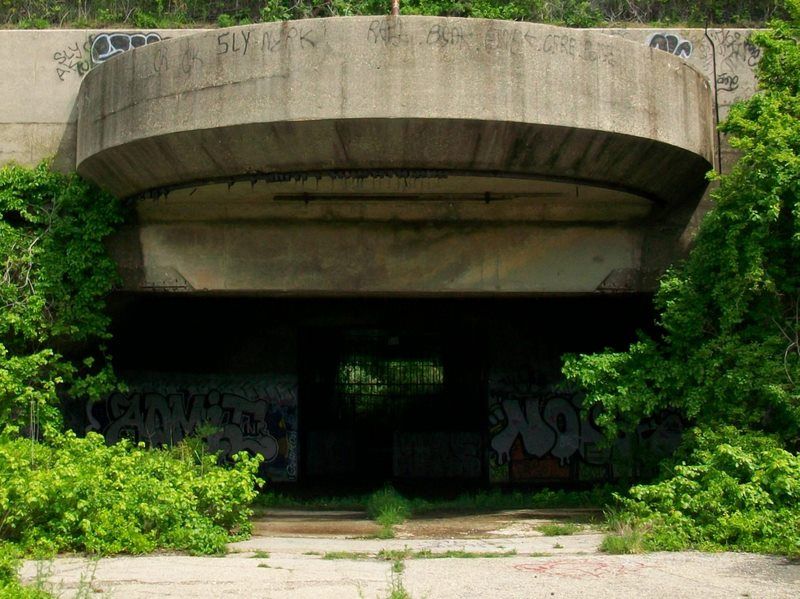
Acquired by the National Park Service in 1974, the fort’s primary function today is recreation, rather than historical education or remembrance; the department seems content to allow many of the buildings that remain to crumble, while the old battlements and silos — consisting of far more sturdy construction — are simply gated and ignored. The site’s star attractions, Battery Harris East and Battery Harris West, rise like specters out of the vegetation along the main road through the property; though you will find nothing on the site telling you so, these striking structures once protected New York with dual 16-inch canons whose projectiles could strike at a range of up to 30 miles in any direction.
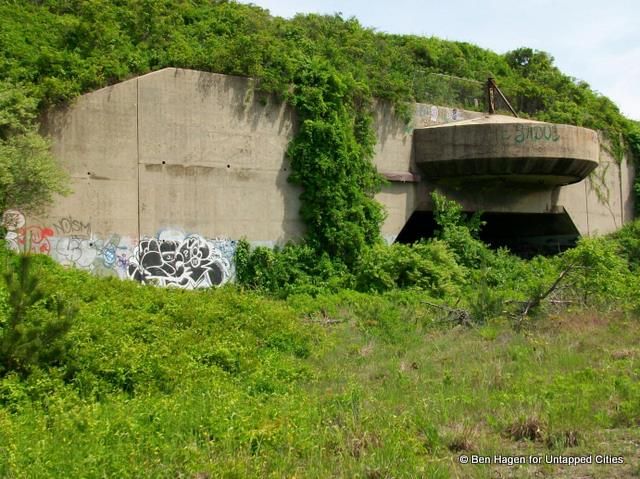
 Battery Harris West (top) and Battery Harris East (bottom). Both housed twin 16-inch guns installed in 1922; the cement encasements, up to 10 feet thick and covered by up to 20 feet of earth, were constructed in 1943.
Battery Harris West (top) and Battery Harris East (bottom). Both housed twin 16-inch guns installed in 1922; the cement encasements, up to 10 feet thick and covered by up to 20 feet of earth, were constructed in 1943.
Closer to the beach, one can find further evidence of Fort Tilden’s history. Two smaller silos (Battery Kessler and Battery 220) remain, buried under dunes that are still effective at concealing them — particularly in the dense vegetation of summer. This vegetation, along with a complete lack of any kind of wayfaring, can make the entire area somewhat of a puzzling place to explore; though Battery Harris East has a set of wooden stairs leading to a small wooden overlook, and once had a sign announcing its presence, today there is nothing to note the old batteries and silos and little effort to connect them to the area’s history. Most of the park’s 302 acres consists of little more than coastal forest with a few paths — some lined with cement or gravel, but many more marked only by small clearings of brush. Though this lack of direction enhances the sense of exploration, it fails to communicate the fort’s historical significance and reduces access to one of the city’s most under-appreciated urban escapes.
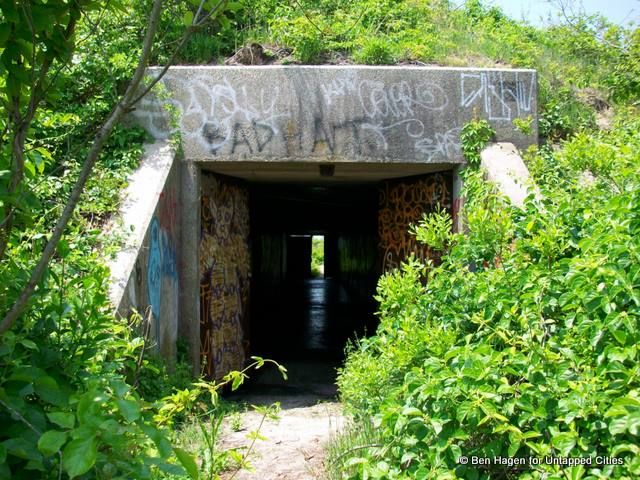
 Exterior and Interior of Battery Kessler; along with Battery 220, this silo housed accessories for 6-inch coastal defense artillery located above the silos.
Exterior and Interior of Battery Kessler; along with Battery 220, this silo housed accessories for 6-inch coastal defense artillery located above the silos.
In addition to the conventional weapons mentioned above, beginning in the 1950s Ft. Tilden was home to Nike Ajax, and later Hercules, missiles. These were stored in an underground silo at the launching site in the western portion of the property; today, this area is inaccessible due to the twin deterrents of an eight-foot fence and dense vegetation. Hercules missiles were capable of carrying nuclear warheads and had an effective range of up to 75 miles; these were housed at the fort until its transferal to the National Park Service in 1974.
In addition to the ruins of yesterday’s military adventures, Fort Tilden today serves as a gathering place for the Rockaway community. The northeastern section, once home to troop housing and other uses related to the daily lives of the fort’s soldiers, is considerably better maintained than the old weapon sites to the west. There are a number of soccer and baseball fields here, the latter providing a home to the Rockaway Little League. This area also holds a community garden and old fort buildings that now house the Rockaway Artists Alliance, Rockaway Theatre Company, and a few private residences. Interest in the Fort’s beaches also seem to be on the rise; positioned just to the west of popular Jacob Riis beach, Fort Tilden’s beaches were largely ignored until recent years, when media attention has led to increased awareness of the beauty and relative seclusion of the fort’s beaches.
To get to Fort Tilden, take the 2 train to its eastern terminus and catch the Q35 to the Rockaway side of the Marine Parkway Bridge.

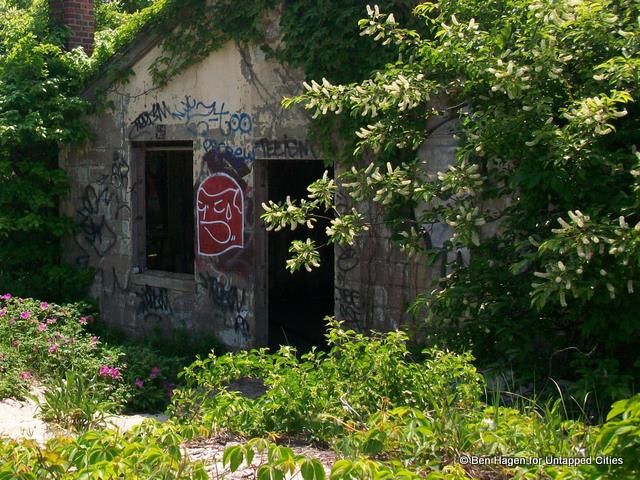
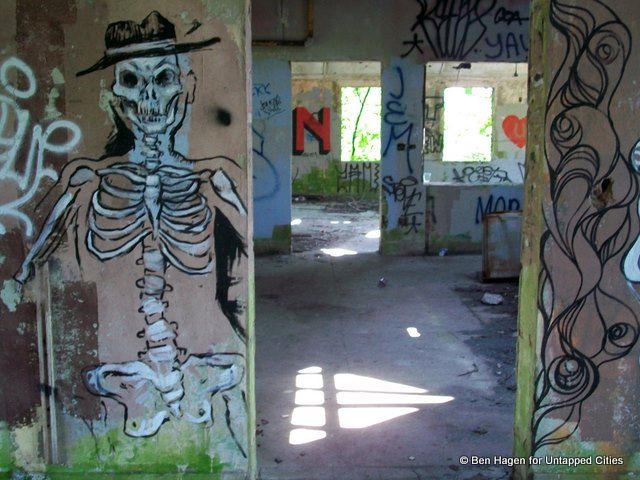 From fort to urban canvas: structures just north of the beach, along the fort’s southern border.
From fort to urban canvas: structures just north of the beach, along the fort’s southern border.
 The exhaust vent of Battery Kessler peeks out from within a dune.
The exhaust vent of Battery Kessler peeks out from within a dune.
 View of Manhattan from atop Battery Harris East.
View of Manhattan from atop Battery Harris East.
 The Fort’s former chapel, located in the northeastern section of the property – where structures have been maintained to a much higher standard.
The Fort’s former chapel, located in the northeastern section of the property – where structures have been maintained to a much higher standard.
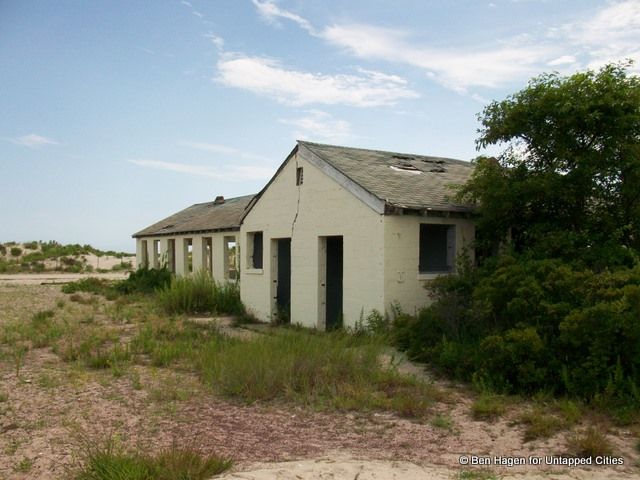
 Some buildings, like this one near the beach, serve as make-shift shade and picnic pavilions for beach-goers.
Some buildings, like this one near the beach, serve as make-shift shade and picnic pavilions for beach-goers.
 Fort Tilden is replete with barely-visible paths through the brush — leading to unidentified and uncertain destinations.
Fort Tilden is replete with barely-visible paths through the brush — leading to unidentified and uncertain destinations.
Subscribe to our newsletter